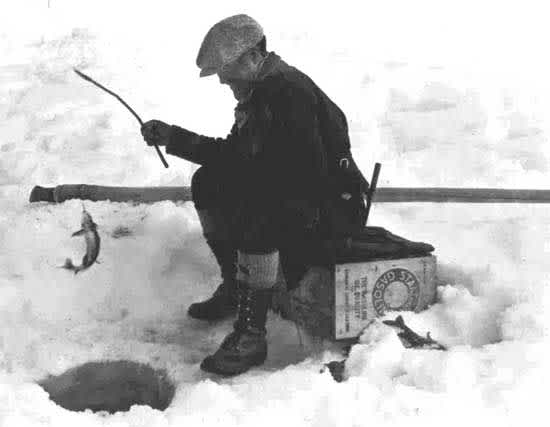How To Ice Fish
OutdoorHub 05.17.11

1. Bait Presentation
Lake ice fishing is a fun challenge because although you may be targeting the same fish you chase in the summer, pretty much everything about this style of fishing is different. For starters you can’t cast your line, so you’re limited as far as the kind of action you can create with your lure. But just because you’re fishing vertically doesn’t mean you can’t trick fish into thinking the bait is moving horizontally. If a normal jig isn’t producing results, try one that’s weighted to lay horizontally in the water column, like a Jammin’ Jig Bobber Fry.
Another effective strategy called “line twisting,” is a good alternative to the standard vertical jigging motion. Just roll the line between your fingers so the bait gently spins in place. You can also make the most out of limited space by moving the line in a circle around the perimeter of the ice hole. Works great in shallow water.
Don’t forget bottom bouncing as a way to get at the deepest fish. Not only is this a tried-and-true technique for many species, but when you drop your bait all the way down you will automatically increase your chances of locating fish suspended at any depth.
2. Bait Choice
Just like in the summer, don’t be afraid to change your bait from live to plastic. Many plastics actually have better wiggling action than live baits, and some are even scented with powerful attractants than might do better than traditional wax worms or grubs.
3. Drill a bunch of holes and use a fish-finder
Before you wet a line or fire up the mini-barbecue, you might as well drill six or seven holes, instead of just one. This way you can move around if your first hole isn’t working. This system works great if you have a fish-finder because you can often figure out which direction a school of fish is headed if they don’t grab the baits at the hole you’re using. Then you can pick up your line and scurry to another hole to try and head them off. You don’t need a lot of ice fishing gear to have a good time, but fish-finders have come way down in price, and even a simple model is worth its weight in gold — in the summer or winter.
4. The hole is a window to a fish’s soul . . .
Just because the hole you’ve cut is a freezing-cold black abyss doesn’t mean you can’t learn something from it. After all, we looking into deep space with telescopes, don’t we? Pull a dark coat over your head and stick your face down close to the water — you’ll be amazed by what’s going on down there. Ideally you should do this with a bait in the water, because the main goal is to observe a fish taking your presentation. Knowing how a perch sucks down a minnow as compared to the way a crappie does it can give you a world of insight as to how you should set up your rig for the best results.
5. Comfort is priority number one
Ask most anglers why they don’t get excited about lake ice fishing and you’ll get either a simple laugh, or a more eloquent response like “IT’S TOO DAMN COLD!!” (followed by a simple laugh). But obviously the people who do their angling in the cold months have figured out ways to avoid that basic problem, and it usually starts with the proper ice fishing gear. An ice shanty is the second easiest way to not be cold. An ice shanty with a propane heater in it is the absolute best way. But what if you don’t have a little condo on the lake, or a way to drag it out there? Bundle up in your warmest gear, and bring two of anything that has a remote chance of getting wet, like gloves and hats. Bring food. Bring safety gear, especially something bright to put out on the ice in case rescue is required, let people know where you’re going and, above all, bring a cell phone with a full battery charge.

Try these ice fishing tips next time you head out onto hard water, and your friends will start looking forward to your February fish fries!

